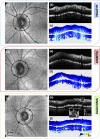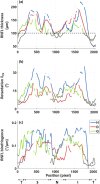Analysis of retinal nerve fiber layer birefringence in patients with glaucoma and diabetic retinopathy by polarization sensitive OCT
- PMID: 33149966
- PMCID: PMC7587266
- DOI: 10.1364/BOE.402475
Analysis of retinal nerve fiber layer birefringence in patients with glaucoma and diabetic retinopathy by polarization sensitive OCT
Abstract
The retinal nerve fiber layer (RNFL) is a fibrous tissue that shows form birefringence. This optical tissue property is related to the microstructure of the nerve fiber axons that carry electrical signals from the retina to the brain. Ocular diseases that are known to cause neurologic changes, like glaucoma or diabetic retinopathy (DR), might alter the birefringence of the RNFL, which could be used for diagnostic purposes. In this pilot study, we used a state-of-the-art polarization sensitive optical coherence tomography (PS-OCT) system with an integrated retinal tracker to analyze the RNFL birefringence in patients with glaucoma, DR, and in age-matched healthy controls. We recorded 3D PS-OCT raster scans of the optic nerve head area and high-quality averaged circumpapillary PS-OCT scans, from which RNFL thickness, retardation and birefringence were derived. The precision of birefringence measurements was 0.005°/µm. As compared to healthy controls, glaucoma patients showed a slightly reduced birefringence (0.129 vs. 0.135°/µm), although not statistically significant. The DR patients, however, showed a stronger reduction of RNFL birefringence (0.103 vs. 0.135°/µm) which was highly significant. This result might open new avenues into early diagnosis of DR and related neurologic changes.
Published by The Optical Society under the terms of the Creative Commons Attribution 4.0 License. Further distribution of this work must maintain attribution to the author(s) and the published article’s title, journal citation, and DOI.
Conflict of interest statement
The authors declare no conflicts of interest.
Figures






Similar articles
-
Early Identification of Retinal Neuropathy in Subclinical Diabetic Eyes by Reduced Birefringence of the Peripapillary Retinal Nerve Fiber Layer.Invest Ophthalmol Vis Sci. 2021 Apr 1;62(4):24. doi: 10.1167/iovs.62.4.24. Invest Ophthalmol Vis Sci. 2021. PMID: 33871570 Free PMC article.
-
Birefringent Properties of the Peripapillary Retinal Nerve Fiber Layer in Healthy and Glaucoma Subjects Analyzed by Polarization-Sensitive OCT.Invest Ophthalmol Vis Sci. 2022 Nov 1;63(12):8. doi: 10.1167/iovs.63.12.8. Invest Ophthalmol Vis Sci. 2022. PMID: 36331260 Free PMC article.
-
Measuring retinal nerve fiber layer birefringence, retardation, and thickness using wide-field, high-speed polarization sensitive spectral domain OCT.Invest Ophthalmol Vis Sci. 2013 Jan 7;54(1):72-84. doi: 10.1167/iovs.12-10089. Invest Ophthalmol Vis Sci. 2013. PMID: 23221076 Clinical Trial.
-
Thickness, phase retardation, birefringence, and reflectance of the retinal nerve fiber layer in normal and glaucomatous non-human primates.Invest Ophthalmol Vis Sci. 2012 Jul 1;53(8):4380-95. doi: 10.1167/iovs.11-9130. Invest Ophthalmol Vis Sci. 2012. PMID: 22570345 Free PMC article.
-
Polarization properties of the retinal nerve fiber layer.Bull Soc Belge Ophtalmol. 2006;(302):71-88. Bull Soc Belge Ophtalmol. 2006. PMID: 17265791 Review.
Cited by
-
Depth-resolved extraction of optical attenuation for glaucoma assessment in clinical settings: a pilot study.Biomed Opt Express. 2022 Jul 26;13(8):4326-4337. doi: 10.1364/BOE.461348. eCollection 2022 Aug 1. Biomed Opt Express. 2022. PMID: 36032564 Free PMC article.
-
Early Identification of Retinal Neuropathy in Subclinical Diabetic Eyes by Reduced Birefringence of the Peripapillary Retinal Nerve Fiber Layer.Invest Ophthalmol Vis Sci. 2021 Apr 1;62(4):24. doi: 10.1167/iovs.62.4.24. Invest Ophthalmol Vis Sci. 2021. PMID: 33871570 Free PMC article.
-
Current Status and Future Perspectives of Optic Nerve Imaging in Glaucoma.J Clin Med. 2024 Mar 28;13(7):1966. doi: 10.3390/jcm13071966. J Clin Med. 2024. PMID: 38610731 Free PMC article. Review.
-
Birefringent Properties of the Peripapillary Retinal Nerve Fiber Layer in Healthy and Glaucoma Subjects Analyzed by Polarization-Sensitive OCT.Invest Ophthalmol Vis Sci. 2022 Nov 1;63(12):8. doi: 10.1167/iovs.63.12.8. Invest Ophthalmol Vis Sci. 2022. PMID: 36331260 Free PMC article.
-
Structure-Function Correlation of Retinal Fibrosis in Eyes with Neovascular Age-Related Macular Degeneration.J Clin Med. 2024 Feb 14;13(4):1074. doi: 10.3390/jcm13041074. J Clin Med. 2024. PMID: 38398387 Free PMC article.
References
-
- Sabanayagam C., Banu R., Chee M. L., Lee R., Wang Y. X., Tan G., Jonas J. B., Lamoureux E. L., Cheng C.-Y., Klein B. E. K., Mitchell P., Klein R., Cheung C. M. G., Wong T. Y., “Incidence and progression of diabetic retinopathy: a systematic review,” Lancet Diabetes Endocrinol. 7(2), 140–149 (2019).10.1016/S2213-8587(18)30128-1 - DOI - PubMed
-
- Corcóstegui B., Durán S., González-Albarrán M. O., Hernández C., Ruiz-Moreno J. M., Salvador J., Udaondo P., Simó R., “Update on Diagnosis and Treatment of Diabetic Retinopathy: A Consensus Guideline of the Working Group of Ocular Health (Spanish Society of Diabetes and Spanish Vitreous and Retina Society),” J. Ophthalmol. 2017, 1–10 (2017).10.1155/2017/8234186 - DOI - PMC - PubMed
Grants and funding
LinkOut - more resources
Full Text Sources
Research Materials
